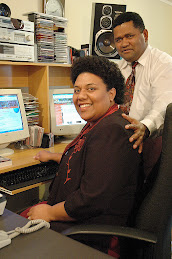 YOU cannot take away the stigma of having been in prison but you can always change the direction of your life after prison. This is the message of former prisoner and now a reformed Christian, Naomi Caveti.
YOU cannot take away the stigma of having been in prison but you can always change the direction of your life after prison. This is the message of former prisoner and now a reformed Christian, Naomi Caveti.Ms Caveti realised her mistake when she sat in the Central Police Station waiting to be transferred to the Korovou Women's Prison in 2006.
Ms Caveti, a mother of five children, is from Ono-i-Lau in the Lau Group. She was sentenced to two years after being found guilty of fraudulently obtaining money from her business partner.Ms Caveti described her life before being prison as one of drinking and being on the wrong side of the law.
"I had this drinking problem and because of that I had previous police cases," she says. "I used to have a bar in my house but my drinking habits never affected my children's life," she stressed.
Ms Caveti had a beche-de-mer business which she co-owned with a Chinese man. "My drinking problem led me to take money from the company and when my partner found out he reported to the police," she said. Ms Caveti said she took $1300 from the company and when she was arrested she even agreed to pay back $700 at the police station. But the officer in charge took the matter ahead and she was eventually jailed for two years.
"I smoked my last cigarette at the Central Police Station where I had to wait to be taken to the Korovou Prison and something happened there which made me rethink my life,' she said. "My mother had brought my clothes in a bag to the station and when I got ready to go to sleep in the station cell that night, I pulled out my blanket and a black book fell out of it.
"My mother had packed packed a Bible with my clothes and when I saw it there I just couldn't hold back my anger. I was angry at myself, I was angry at the world and at almost everyone in my life. "I didn't want to smoke another cigarette and I just sat there and cried because I knew that I was going to a place which was very cold and cruel."
Ms Caveti said she spent her days in prison in solitude and thought about what she had been doing and what went wrong. "I come from a broken family and I was the eldest in my family. I realised in prison that I had been looking for love but in all the wrong places. "But the most life-changing moment was when I received a letter from my eldest daughter who was in Class 5 then. "She told me that I was not to worry about my children because they were praying to God everyday and they were okay.
"She told me to keep my faith in the Lord and to pray everyday even if I was sad." Sitting there with tears in her eyes, Ms Caveti said there came a stage when she just forgot about her children and just did not want to come out of prison.
"But then I began to think of my children and I began to miss them and that was when I applied to serve the rest of my sentence outside the prison. "I was released on good behaviour in October last year."
Now Ms Caveti is a member of the All Nations Church and works with the Pacific Youth Correctional Ministries in Levuka. "I live in Levuka with my children and I teach Bible studies to prisoners at Levuka Prison.
"I know how hard it is for people to come out of prison and lead a normal life but I would still advise them to be honest and lead a life of truth". "I understand that the people find it very hard to accept people who come out of prison but if there is a genuine wish to change for the better in their life then the community and the church should allow the former prisoners to come back into the society."
Adpted from Fijitimes Online.










